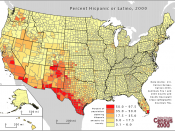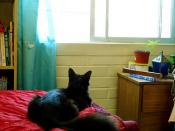Lasswell's three functions of media; surveillance, correlation and transmission, as described in Clint C. Wilson, Felix F. Guitierrez, and Lena M. Chao's book "Racism, Sexism, and the Media: The Rise of Class Communication in Multicultural America" directly apply to Lalo Alcarez's daily newspaper comic strip "La Cucaracha." Surveillance appropriately relates when considering how Alcarez underscores stigmas frequently related with Latino-Americans. Correlation is accurately depicted by Alvarez through playing on stereotypes commonly associated with Latino-Americans. Transmission is portrayed in La Cucaracha by trying to disseminate myths about Latino-Americans using sarcasm. Wright's additional functions of entertainment and economic service are perhaps the most important functions of La Cucaracha. While it does have social and political undertones, La Cucaracha is mainly created for the purpose of entertainment. Likewise, the foremost purpose of a comic strip is to give certain publications an economic edge over others.
Surveillance is obvious in every installment of "La Cucaracha". In the first and second panels of example one of La Cucaracha, Cuco replies to his father's request of him to get a job by saying, "Haven't you heard, Pop? Those law-breaking illegal aliens have taken all the low wage jobs teens used to fill..." This use of irony is one of the ways La Cucaracha author Lalo Alcarez brings to light the preconceived notions often applied to both legal and illegal Latino-Americans. He continues to use satire in the second example when he shows a white man walking by a sleeping Latino immigrant, the white man mutters, "Lazy immigrant!"
The correlation function can be sufficiently seen in La Cucaracha by Alcarez's use of stigmas to illustrate the way that he believes Latino-Americans are interpreted by the nation. In panel two of the first example, Alcarez, uses sarcasm to show how Latino-Americans are viewed by others in the American society when he shows Cuco's father looking wide-eyed and dumbfounded. "Really?"3 he says, when Cuco explains that illegal immigrants have taken all of the jobs. He also uses irony in the third panel of the first example by portraying Cuco's father with a wide smile on his face when Cuco expresses his "outrage" at illegal immigrants.
The transmission element of media is evident in both examples of La Cucaracha. In panel one of the first example of La Cucaracha, Cuco Rocha's father warns Cuco, "I said I want you to get a job this summer, young man!" In this way, the strip works to convince Latinos and non-Latinos alike that preconceived notions of the Latino subculture of American society (made up of both immigrant and American Latinos), such as laziness, are false. The same agenda is applied in the second example when the first seven panels show a Latino immigrant leaving home, walking in the hot desert, tunneling under the United States/ Mexican border, running from border control, making it to the city, and finally, working: all in the name of a better life for his family.
The entertainment value of this comic strip is evident in the humor of the first example. After Cuco exclaims, "The next time I see an illegal, I'm gonna show my outrage!"3 he immediately goes outside and hugs the nearest "illegal immigrant." In the second example, the humor is found in the satire of the white man referring to the immigrant as lazy after the immigrant has traversed the desert and worked all day.
The history and present use of comic strips is mainly in the name of economic gain. Comic strips originated to boost sales of competing newspapers1 and; more recently, the addition or cancellation of comic strips directly correlate to the likes and dislikes of readers and editors of these publications. In this way, La Cucaracha is no different. After the strip originally appeared in newspapers across the country it was pulled from many of them because Latino-Americans complained that it was racist.
Clearly, Alcarez applies all five functions of media: surveillance, correlation, transmission, entertainment and economic service to his comic strip La Cucaracha. He accomplishes this with a combination of sarcasm, stereotyping and a hint of his own social/political point of view.





